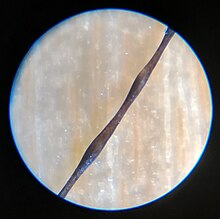Monilethrix
| Monilethrix | |
|---|---|
| Other names | Moniliform hair syndrome |
 | |
| Beaded hair (60x magnification). | |
| Specialty | Medical genetics |
Monilethrix (also referred to as beaded hair)[1] is a rare autosomal dominant hair disease that results in short, fragile, broken hair that appears beaded.[2][3] It comes from the Latin word for necklace (monile) and the Greek word for hair (thrix).[4] Hair becomes brittle, and breaks off at the thinner parts between the beads. It appears as a thinning or baldness of hair and was first described in 1897 by Walter Smith[5]
Signs and symptoms
Some indicators of monilethrix are small bumps on the skin, mainly on the scalp, neck and arms. In most cases, firm, dark papules, covered with dark scales and crusts appears on the skin, especially the scalp.[6] The affected individual would have beaded hair strands. The possible areas for the hair loss are the eyebrows, eyelashes, limbs, and pubic region. Hair strands are usually dull, dry, and brittle. The strands are prone to mild to severe breakage, causing onset alopecia, especially during pregnancy. Fingernail and toenails tend to appear abnormal.[7] The onset for this disease varies from person to person. The frequency of monilethrix is currently unknown.
Presentation
Newborns are not born with Monilethrix; it usually develops within the first few months of life. The presentation may be of

Diagnosis
Monilethrix may be diagnosed with trichoscopy[8][9] and other forms of dermoscopy. Light microscopic examination is diagnostic and reveals elliptical nodes of normal thickness and intermittent constrictions, internodes at which the hair easily breaks. Under examination, the hair is beaded. The beading is the result of a periodic narrowing of the shaft with nodes separated by about 0.7 mm.[10] In general, there is a tendency for spontaneous improvement with time, especially during puberty and pregnancy, but the condition never disappears completely.[11]
Genetics
Monilethrix is caused by mutations affecting the genes KRTHB1 (
Treatment
No specific treatment exists for monilethrix. Spontaneous resolution following puberty has occurred in some cases. In affected females, the condition improves during pregnancy. Genetic counseling will be of benefit for affected individuals and their families. Other treatment is symptomatic and supportive.[6]
Epidemiology
Currently, the frequency for this disease is unknown and affects both men and women. Signs and symptoms either show up spontaneously at birth or around the age of 2.[6] The symptoms may change or remain the same throughout one's life, but are usually present after the first few months after birth.
See also
- List of cutaneous conditions
- List of conditions caused by problems with junctional proteins
- List of cutaneous conditions caused by mutations in keratins
References
- ISBN 978-0-7216-2921-6.
- ^ PMID 19400537.
- ISBN 978-0-07-138076-8.
- NIH Office of Rare Diseases Research. Archived from the originalon 2012-07-30. Retrieved 2011-01-15.
- PMID 30969635.
- ^ a b c "Monilethrix". NORD (National Organization for Rare Disorders). Retrieved 2022-03-17.
- ^ "Monilethrix: MedlinePlus Genetics". medlineplus.gov. Retrieved 2022-03-17.
- PMID 18664157.
- PMID 21886705.
- S2CID 19702884.
- PMID 16575393.
- PMID 16702971.
